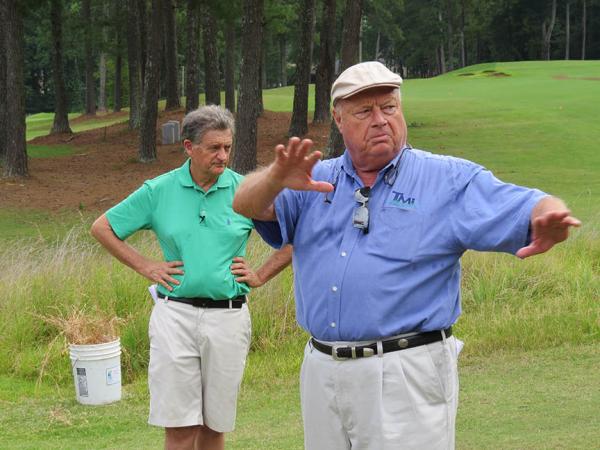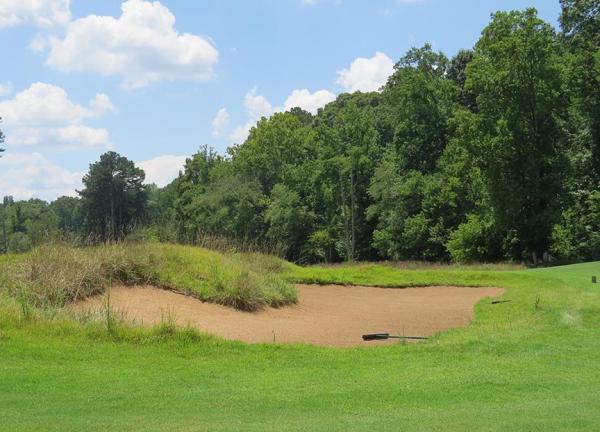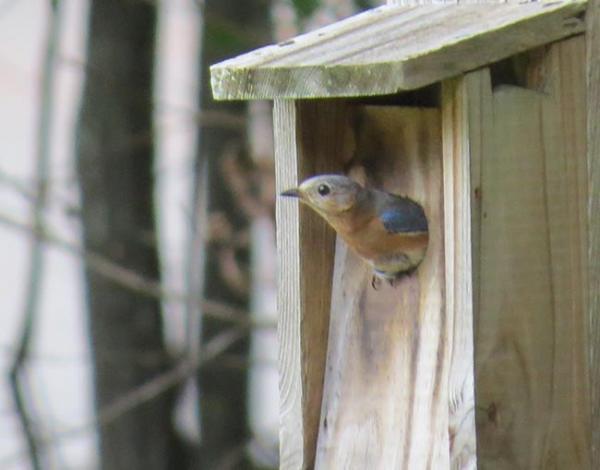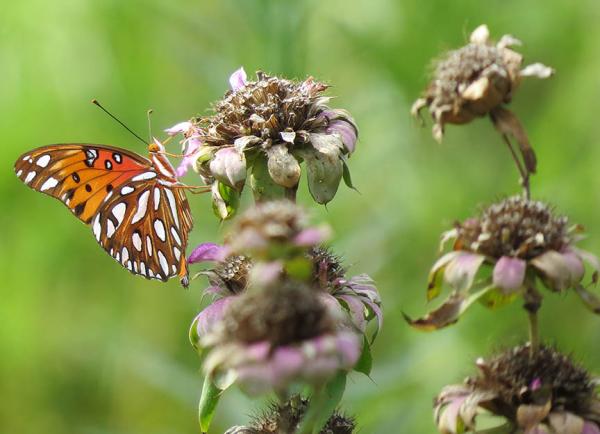The way Mark Hoban sees it, there should be much more to the golf experience than getting the ball into the hole in the fewest shots possible. The experience also should include a field of play that is aesthetically pleasing to the eye, requires minimal inputs and looks like it is part of the surrounding landscape - all while providing a tough, fair test for golfers.
 All of that was on display recently as Hoban hosted his inaugural organic and native grasses field day at Rivermont Golf Club in Johns Creek, Georgia.
All of that was on display recently as Hoban hosted his inaugural organic and native grasses field day at Rivermont Golf Club in Johns Creek, Georgia.For the past decade, Hoban has been incorporating organic nutrients, biologicals and native grasses to make Rivermont stand out as a unique property in the golf-heavy Atlanta market. And there was enough interest in what he has been doing that more than 70 people registered to attend the event.
For Hoban, the purpose of the event was simple - to share with others information on his sustainable management program in hopes of driving interest in organic golf course maintenance.
"It's dynamic and exciting," Hoban said. "I'd like to get more people into it. There are a lot of benefits."
The experience included six stations where visitors could get a crash course in golf course maintenance the Hoban way. Those stations were: Hoban's field trials, University of Georgia field trials, pollinator and butterfly habitats, organic topdressing, native grasses and composting.
Each was manned either by Hoban, or an expert in the field who has helped him over the years develop his program.
Hoban creates and buys both thermal and worm compost as ingredients in his own compost tea that introduces beneficial microbes, fungi, protozoa and nematodes to the soil. Hundreds of research trials are under way at Rivermont, examining the effects of dozens of organic nutritional programs and how effective they are either alone or in combination with other organic and inorganic products. Some of the trials are maintained by Hoban and his crew while others are the work of University of Georgia research specialists.
The grasses around tees are not maintained. I've never understood doing that. The only person who steps foot on it is the person mowing it."
Hoban rated each of his trials for attendees, but he admits he needs more data over several years to determine which programs work best under which conditions.
"A lot of what we are doing is not to fruition yet," he said. "I like the feel-good stories: 'I tried it. It works great.' But we want the hard data."
Rivermont indeed stands out among Atlanta golf courses. The property occupies 188 acres, but through the years, Hoban has converted 26 acres of managed Bermudagrass to a variety of native plants that combine to frame golf holes with a palette of colors throughout the year.
Large patches that once were rough areas now are dotted with grasses that produce hues of green, orange and brown, and teeboxes are surrounded with hairy varieties of broomshedge, tall fescues and orchard grass.
"The grasses around tees are not maintained," Hoban said. "I've never understood doing that. The only person who steps foot on it is the person mowing it."
Native grasses in once-managed areas of the rough are not watered or fertilized, and they are not mowed.
"We've reduced rough mowing from two-and-a-half days to one," Hoban said. "That is huge for us to get all the roughs done in one day.
"That allows us to concentrate on the center cut."
 Even the bunker sand at Rivermont is different with a dark brown color that looks more like dirt than sand. With clumps of native grasses in and around the bunkers and scruffy edges around the perimeter, the bunkers help invoke a feel of a golf course from another generation.
Even the bunker sand at Rivermont is different with a dark brown color that looks more like dirt than sand. With clumps of native grasses in and around the bunkers and scruffy edges around the perimeter, the bunkers help invoke a feel of a golf course from another generation.That was what Rivermont owner Chris Cupit, Hoban and architect Mike Riley were trying to create during a 2006 renovation.
"I wanted something that looked like it was built in 1910, 1920, the golden age of architecture," Riley said. "Chris wanted something completely different. If everyone else was going up, we were going down. If everyone was going left, we were going right."
Rivermont is different without being contrived, tricked up or hokey.
Some fairways and landing areas are open, while others are narrow. Some greens might be 4,000 square feet - or less - in size, while some others swell to as much as 10,000 square feet.
"We wanted to make it look like we found the golf course on the land, instead of shaping the golf course to the land," Riley said. "There are a lot of different textures and a lot of different colors at different times of the year, all adding to the composition of the golf hole.
"There were trade-offs on how much we could do and still keep membership interested in the golf course."
Those trade-offs also included a largely organic management plan that has helped Hoban save a little money. His compost tea program costs a grand total of $1.25 per acre. He harvests his own broomsedge to collect seed so he can plant new areas each year and expand his native grass areas. That is a smart move since that seed retails for about $900 per pound, according to Butch Gill of Turf Merchants.
"If you can educate people, save money, save labor and save fertility, it's going to make golf more affordable," said Gill, who was on hand to teach field day visitors about native grasses.
The area around Gill's station included native grasses planted last year, two years ago and four years ago, each with a distinctive appearance.
"This is an age of instant gratification, which means the golfer doesn't have the patience to grow this stuff in. This is not something that is instant. You need to have a rotation, and you have to educate members on where you are going with a program like this, or I can replace this whole fairway for you for about $600,000.
"This is not your ordinary rodeo."
If there was one consistent message from one station to the next, it was the need to maintain open lines of communication with the owner and members so they know the method to the madness.
There is a misconception that we nuke the golf course and besides the grass and the golfer everything else is dead, and that's just not true," Hoban said. "Our thing, is we don't just tell the golfer, they can see it."
Hoban's office is an open door, and he is eager to share his message with anyone who wants to hear it, even golfers who often are treated to guided tours so they can learn why he is doing what he is doing.
"There is a misconception that we nuke the golf course and besides the grass and the golfer everything else is dead, and that's just not true. Our thing, is we don't just tell the golfer, they can see it."
 Despite the touchy-feely experience, some are more receptive to the message than others.
Despite the touchy-feely experience, some are more receptive to the message than others."It's not just educating, it's selling," said Neil Thelen, a member at Rivermont for more than 15 years. "It took two to three years for members to get behind this program.
"It's still a struggle. Some members were quite hostile about this program, but it looks like heaven out here now. It took a while to educate them.
"When they see what they think is a problem, they want it fixed right now. Roll out some sod and away we go."
Nothing at Rivermont is that simple, especially applying nutrients to the turf.
Hoban creates and buys both thermal and worm compost as ingredients in his own compost tea that introduces beneficial microbes, fungi, protozoa and nematodes to the soil. He incorporates carbon-enhanced topdressing sand loaded with fulvic and humic acids that provide a food source for the microbes.
There are other benefits to the carbon sand. Brown in color, it brushes into the turf easily and is nearly invisible to golfers.
"When you use white sand, golfers are always asking why we're topdressing," Hoban said.
"With the brown sand, the carbon helps the biology, then you brush it in, throw some water on it and it's gone. You get the benefits of the carbon, which is longer, stronger roots, and the golfers have no idea you topdressed."
If you're not killing some grass now and then not learning anything. You're not finding out what will work what won't work, and you won't know the parameters of it."
The program is not without its pitfalls.
"You don't know how far you can go with a program like this until you go too far," Hoban said. "This year, we went too far."
A difficult fall season in 2015 coupled with testing the limits of his program last spring combined to produce disease pressure, thinning turf in the fairways and a lot of upset golfers.
Hoban's mentor, 84-year-old Palmer Maples Jr., made the trip from Kansas City, Missouri, and said a little dead turf here and there helps superintendents discover their boundaries.
"If you're not killing some grass now and then, you're not learning anything," Maples said. "You're not finding out what will work and what won't work, and you won't know the parameters of it."
Much of what Hoban is doing includes helping organisms other than those found in the soil.
 Emily Dobbs came armed with data to share with visitors about why pollinator zones and areas that are friendly to butterflies are a good idea on golf courses. Dobbs, a doctoral student at Emory University where she manages the Brosi Laboratory and studies the causes and effects of pollinator decline, helped establish the first Operation Pollinator zone for golf courses in 2011 when she was a master's student under entomologist Dan Potter, Ph.D., at the University of Kentucky.
Emily Dobbs came armed with data to share with visitors about why pollinator zones and areas that are friendly to butterflies are a good idea on golf courses. Dobbs, a doctoral student at Emory University where she manages the Brosi Laboratory and studies the causes and effects of pollinator decline, helped establish the first Operation Pollinator zone for golf courses in 2011 when she was a master's student under entomologist Dan Potter, Ph.D., at the University of Kentucky.At Kentucky, she established six zones around Lexington, including some on golf courses and at the UK research station. She also worked with Applewood Seed Co. in Arvada, Colorado to develop seed programs for plants native to the bluegrass state.
Her research showed that the typical golf course in central Kentucky might have enough flora to attract a half-dozen bee species. Establishing zones filled with a diverse mix of the right native plants, however, can attract all sorts of beneficial insects. After the first year of her pollinator zone program, she found as many as 25 different types of bees on her plots. In year two, as many as 75 bee species were flitting about golf courses in Lexington.
"That number is where you would top out for any location in Kentucky. The result is that we found maximum effort in two years," Dobbs said.
"We never expected to find that."
Operation Pollinator, a Syngenta initiative, is now on 14 Marriott golf courses, including the Griffin Gate Resort in Lexington, as well as 200 other locations across 30 states, according to Syngenta's Walt Osborne.
Like other parts of an organic program, establishing pollinator zones requires educating members about what you are doing. That is something Dobbs learned when she was first establishing the program in Kentucky.
"Most of the objections for OP program are because of aesthetics and mitigating disruption to play, which you can accomplish by choosing the right site," she said. "It's a matter of education for changing aesthetic preferences. People like things that look good if they are doing good, education. That might include giving them brochures on the OP program, having field days. More education will change perception of aesthetics."
Hoban also has established 28 bird boxes throughout the Rivermont property, which are managed by women who are members at the club. A total of 115 bluebirds, titmice and chickadees were fledged at the course last year.
"Golf is not just about where is your ball and how many strokes does it take to get there," Hoban said. "There's much more to it than that."

